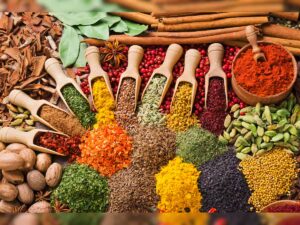- GS-3: Economy (Agricultural Exports, Value Addition in Agriculture)
- GS-3: Science & Tech (Agri-based Pharmaceuticals, Food Processing)
Key Highlights
India’s Position in the Global Spice Market:
- India is the largest producer and exporter of spices, yet its share in the $4 billion global seasoning market is only 0.7%.
- Current spice exports: 1.5 million tonnes worth $4.5 billion, while the global spice industry is valued at $20 billion.
- China (12%) and the U.S. (11%) hold a larger share in value-added spice exports.
Need for Value Addition & Export Growth:
- Only 48% of India’s spice exports are value-added, while the rest are raw whole spices.
- To reach the $10 billion export target by 2030, value-added spice exports must rise to 70%.
- India has 15 agro-climatic zones, offering potential for regional spice diversification.
Emerging Markets & New Opportunities:
- North Eastern States, Odisha, and Jharkhand are emerging spice producers.
- Nutraceutical and pharmaceutical industries offer high-value applications for spices.
Sustainability & Pest Management:
- Focus on integrated pest management, sustainable cultivation, and quality certification.
- FPOs (Farmer Producer Organizations) are being trained in spice processing, reducing pesticide use, and improving exports.
Analysis & Way Forward
- Scaling up value-added spice exports will improve India’s global competitiveness.
- Encouraging spice-based pharmaceuticals can increase revenue streams.
- Strengthening FPO networks & certification standards will ensure quality & sustainability in exports.
Mains Mock Question:
“Discuss the potential of India’s spice industry in achieving higher global market share through value addition. Suggest policy measures to enhance exports.”




